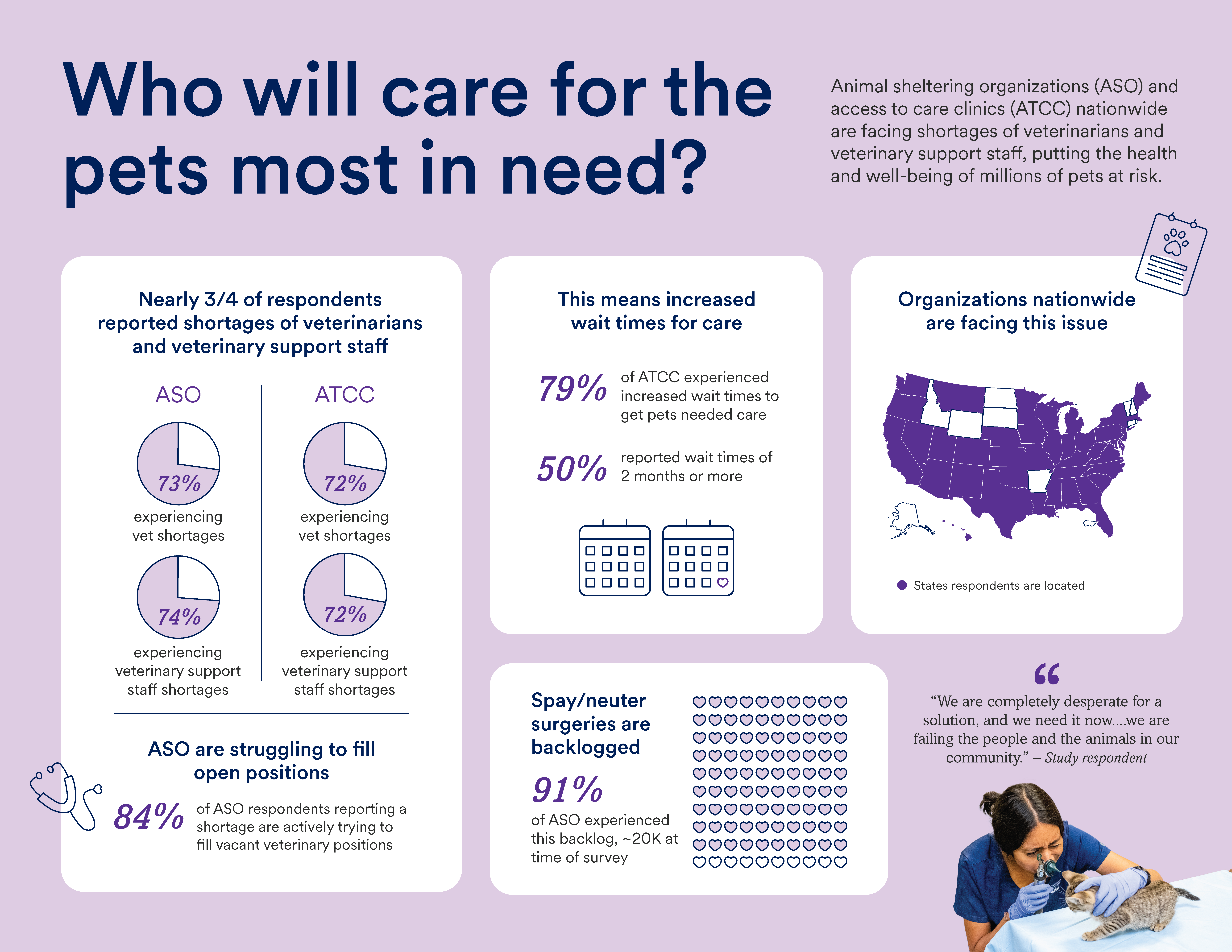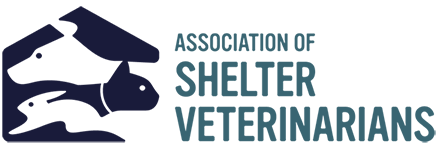The Nonprofit Veterinarian Shortage: Who Will Care for the Pets Most in Need?
DOI:
https://doi.org/10.56771/jsmcah.v3.75Keywords:
veterinary workforce, shelter veterinarian, veterinary nurse, veterinary technician, veterinary assistant, nonprofit veterinarian, access to veterinary care, spay/neuter, animal shelter, shelter medicine, public health, dogs, catsAbstract
Introduction: The national shortage of veterinarians, and the technicians and assistants who support them, has affected private practices, emergency and specialty clinics, agricultural practices, public health departments, and veterinary college faculty. The purpose of this study was to determine the impact of the veterinary workforce shortage on veterinary care provided at two types of public practice: (1) veterinary care for cats and dogs housed temporarily in animal sheltering organizations (ASOs) and (2) veterinary clinics aimed at increasing access to care for animals in the community.
Methods: A novel survey was disseminated to 333 ASOs receiving a minimum of 2,500 animals annually and 118 access to care clinics (ATCCs) that partner with or receive grants from the national animal welfare nonprofit Petco Love. Surveys included questions about staffing and vacant positions for veterinarians and veterinary support staff, current hiring efforts for veterinarians, and delays in animal care.
Results: A total of 179 ASOs completed the survey (54% response rate). Most reported being short-staffed for veterinarians (130/179; 73%) and for veterinary support staff (132/179; 74%). Of the 143 ASOs answering a question about spay/neuter surgeries, 130 (91%) reported having a backlog with a combined total of 18,648 animals awaiting surgery. A total of 57 ATCCs responded to the survey (48% response rate). Of these, 41 (72%) reported being short-staffed for both veterinarians and veterinary support staff. As a result, clients were waiting longer than usual for care at 45 clinics (79%), with delays of 2 months or more at 28 clinics (51%).
Conclusion: This study highlights the critical impact of severe veterinary workforce shortages on nonprofit organizations responsible for medical care for the most vulnerable cats and dogs. These shortages pose substantial risks to animal welfare, the human–animal bond, and public health.
Downloads
References
1.
American Association of Veterinary Medical Colleges. AAVMC Statement on U.S. Veterinary Workforce. Association Statement. 2022. https://www.aavmc.org/wp-content/uploads/2022/07/AAVMC-Statement-on-Workforce-July-2022.pdf. Accessed August 28, 2024.
2.
Carlson R. AVMA Is Committed to Addressing the Industry’s Challenges. Secondary Source. Today’s Veterinary Business; 2023. https://todaysveterinarybusiness.com/avma-veterinarians-1023. Accessed August 28, 2024.
3.
Lloyd JW. Pet Healthcare in the US: Are There Enough Veterinarians? Secondary Source. Animal Health Economics LLC; 2021. https://marsveterinary.com/tackling-the-veterinary-professional-shortage/. Accessed August 28, 2024.
4.
Lloyd JW. Pet Healthcare in the US: Are There Enough Veterinary Nurses/Technicians? Is There Adequate Training Capacity? Secondary Source. Animal Health Economics, LLC; 2021. https://marsveterinary.com/tackling-the-veterinary-professional-shortage/. Accessed August 28, 2024.
5.
Rothstein J. Shortage of Veterinary Professionals May Be a Blessing in Disguise for the Profession. Secondary Source. DVM 360; 2023. https://www.dvm360.com/view/shortage-of-veterinary-professionals-may-be-blessing-in-disguise-for-the-profession. Accessed August 28, 2024.
6.
Arrington A, Markarian M. Serving pets in poverty: a new frontier for the animal welfare movement. Sustain Dev Law Policy. 2018;18:11. http://digitalcommons.wcl.american.edu/sdlp/vol18/iss1/11. Accessed August 28, 2024.
7.
San Francisco SPCA. Suffering, Euthanasia in Shelters Will Rise Without Immediate Action. Association Survey. https://www.sfspca.org/access-to-veterinary-care-survey-2023/. Accessed August 28, 2024.
8.
Human-Animal Policy Center. Colorado Veterinary Professional Survey. Collaborative Peer-Reviewed Survey Report. 2023. https://sites.warnercnr.colostate.edu/animalhumanpolicy/wp-content/uploads/sites/171/2023/10/AHPC-Veterinary-Professional-Survey-Results.pdf. Accessed August 28, 2024.
9.
Guerios SD, Porcher TR, Clemmer G, Denagamage T, Levy JK. COVID-19 associated reduction in elective spay-neuter surgeries for dogs and cats. Front Vet Sci. 2022;13;9:912893. doi: 10.3389/fvets.2022.912893
10.
Shelter Animals Count the National Database. Organization Report. 2023. https://www.shelteranimalscount.org/stats. Accessed August 28 2024.
11.
Falconer J. Crisis of Veterinary Care: How Can Nonprofits Survive the Veterinary Workforce Shortage? Association Website Article. https://humanepro.org/magazine/articles/crisis-veterinary-care. Accessed August 28, 2024.
12.
DeTar L, Doyle E, O’Quin J, et al. The guidelines for standards of care in animal shelters. J Shelter Med Community Anim Health. 2022;1:1–76. doi: 10.56771/ASVguidelines.2022
13.
Best Friends Animal Society. The State of Animal Welfare Today. Association Report. https://bestfriends.org/no-kill-2025/animal-welfare-statistics. Accessed August 28, 2024.
14.
Griffin B, Bushby PA, McCobb E, et al. The association of shelter veterinarians’ 2016 veterinary medical care guidelines for spay-neuter programs. J Am Vet Med Assoc. 2016;249:165–188. doi: 10.2460/javma.249.2.165
15.
Access to Veterinary Care Coalition. Access to Veterinary Care: Barriers, Current Practices, and Public Policy. Peer-Reviewed Report. 2018. https://pphe.utk.edu/wp-content/uploads/2020/09/avcc-report.pdf. Accessed August 28, 2024.
16.
White SC, Scarlett JM, Levy JK. Characteristics of clients and animals served by high-volume, stationary, nonprofit spay-neuter clinics. J Am Vet Med Assoc. 2018;253:737–745. doi: 10.2460/javma.253.6.737
17.
Neal SM. Correlating access to primary medical care and veterinary care providers: a novel application of spatial gravity modelling. Vet Sci. 2023;10:565. doi: 10.3390/vetsci10090565
18.
Reese L, Li X. Animal welfare deserts: human and nonhuman animal inequities. Front Vet Sci. 2023;10:1189211. doi: 10.3389/fvets.2023.1189211
19.
Smith SM, George Z, Duncan CG, Frey DM. Opportunities for expanding access to veterinary care: lessons from COVID-19. Front Vet Sci. 2022;9:804794. doi: 10.3389/fvets.2022.804794
20.
Neal SM, Greenberg MJ. Putting access to veterinary care on the map: a veterinary care accessibility index. Front Vet Sci. 2022;9:857644. doi: 10.3389/fvets.2022.857644
21.
Bunke L, Harrison S, Angliss G, Hanselmann R. Establishing a working definition for veterinary care desert. J Am Vet Med Assoc. 2023;262:1–8. doi: 10.2460/javma.23.06.0331
22.
Neal SM, Greenberg MJ. Veterinary care deserts: what is the capacity and where is it? J Shelter Med Community Anim Health. 2022;1:2. doi: 10.56771/jsmcah.v1.2
23.
Ouedraogo FB, Bain B, Hansen C, Salois M. A census of veterinarians in the United States. J Am Vet Med Assoc. 2019;255:183–191. doi: 10.2460/javma.255.2.183
24.
Mars Veterinary Health. Tackling the Veterinary Professional Shortage. Corporate Report. https://www.marsveterinary.com/tackling-the-veterinary-professional-shortage/. Accessed August 28, 2024.
25.
Salois M, Golab G. Are we in a veterinary workforce crisis? Understanding our reality can guide us to a solution. J Am Vet Med Assoc. 2021;259:559–586. doi: 10.2460/javma.259.6.559
26.
Veterinary Industry Tracker Data Trends from Veterinary Practices. AVMA and Vetsource Data & Insights Survey Data. https://www.avma.org/resources-tools/veterinary-economics/veterinary-industry-tracker. Accessed August 28, 2024.
27.
Bushby PA. High-quality, high-volume spay–neuter: access to care and the challenge to private practitioners. J Feline Med Surg. 2020;22:208–215. doi: 10.1177/1098612X20903600
28.
Cammisa HJ, Hill S. Payment options: an analysis of 6 years of payment plan data and potential implications for for-profit clinics, non-profit veterinary providers, and funders to access to care initiatives. Front Vet Sci. 2022;9:895532. doi: 10.3389/fvets.2022.895532
29.
Kreisler RE, Spindell ME, Rishniw M. Surveys of salary, benefits, and job responsibilities for veterinarians employed in the field of shelter medicine in the United States conducted in 2011 and 2018. Top Companion Anim Med. 2020;39:100430. doi: 10.1016/j.tcam.2020.100430
30.
American Veterinary Medical Association. 2023 AVMA Report on the Economic State of the Veterinary Profession. AVMA Economic & Market Research Report. https://ebusiness.avma.org/ProductCatalog/product.aspx?ID=2094. Accessed August 28, 2024.
31.
Kogan L, Schoenfeld-Tacher R, Carney P, Hellyer P, Rishniw M. On-call duties: the perceived impact on veterinarians. Front Vet Sci. 2021;8:740852. doi: 10.3389/fvets.2021.740852
32.
Kogan LR, Rishniw M. Differences in perceptions and satisfaction exist among veterinarians employed at corporate versus privately owned veterinary clinics. J Am Vet Med Assoc. 2023;261:1838–1846. doi: 10.2460/javma.23.06.0326
33.
Veterinary Business Advisors, INC. Compensation Best Practices in 2020. Secondary Source. https://veterinarybusinessadvisors.com/compensation-best-practices-in-2020/. Accessed August 28, 2024.
34.
Lederhouse C. Veterinary technicians being paid more but still face concerns about wages, burnout, debt. J Am Vet Med Assoc. 2023;261:465–479. doi: 10.2460/javma.261.4.465
35.
Volk JO, Schimmack U, Strand EB, et al. Executive summary of the Merck Animal Health Veterinarian Wellbeing Study III and Veterinary Support Staff Study. J Am Vet Med Assoc. 2022;260:1547–1553. doi: 10.2460/javma.22.03.0134
36.
Rogelberg SG, Reeve CL, Spitzmüller C, et al. Impact of euthanasia rates, euthanasia practices, and human resource practices on employee turnover in animal shelters. J Am Vet Med Assoc. 2007;230:713–719. doi: 10.2460/javma.230.5.713
37.
Andrukonis A, Protopopova A. Occupational health of animal shelter employees by live release rate, shelter type, and euthanasia-related decision. Anthrozoös. 2020;33:119–131. doi: 10.1080/08927936.2020.1694316
38.
Scotney RL, McLaughlin D, Keates HL. A systematic review of the effects of euthanasia and occupational stress in personnel working with animals in animal shelters, veterinary clinics, and biomedical research facilities. J Am Vet Med Assoc. 2015;247:1121–1130. doi: 10.2460/javma.247.10.1121
39.
Andrukonis A, Hall NJ, Protopopova A. The impact of caring and killing on physiological and psychometric measures of stress in animal shelter employees: a pilot study. Int J Environ Res Public Health. 2020;17:9196. doi: 10.3390/ijerph17249196
40.
Powell L, Reinhard CL, Serpell J, Watson B. Workplace relations and opportunities for career development impact the retention of veterinarians in shelter medicine. Front Vet Sci. 2021;8:732105. doi: 10.3389/fvets.2021.732105
41.
Powell L, Reinhard CL, Serpell J, Watson B. A survey of veterinary student and veterinarian perceptions of shelter medicine employment. J Vet Med Educ. 2023;50:27–52. doi: 10.3138/jvme-2021-0112
42.
Stull JW, Shelby JA, Bonnett BN, et al. Barriers and next steps to providing a spectrum of effective health care to companion animals. J Am Vet Med Assoc. 2018;253:1386–1389. doi: 10.2460/javma.253.11.1386
43.
McCobb E, Crawford PC, Harrold ML, et al. Shelter medicine sustainability from an academic perspective: challenges and issues. J Vet Med Educ. 2023;50(6):611–617. doi: 10.3138/jvme-2022-0080

Additional Files
Published
Issue
Section
License
Copyright (c) 2024 Susanne Kogut, Meredith L. Montgomery, Julie K. Levy

This work is licensed under a Creative Commons Attribution 4.0 International License.









